Introduction
At the end of the Core Concept article, the Author posed some interesting questions. If an Active Pulse refreshes an Active Pulse, why can't human beings engage in one Active Pulse after another? What is the purpose of a Rest Pulse, if the Active Pulse serves the same refreshing purpose? The current article proposes some answers to these questions.
A Rest Break provides Cognitive Refreshment
To even begin to propose some answers, we need to reestablish the context for the questions.
Multiple experiments have shown that our cognitive performance is diminished by sleep deprivation and enhanced by naps. In other words, both sufficient sleep and a well-timed nap can enable us fulfill our cognitive potentials. The inference is straightforward: humans require a rest break to refresh cognitive potentials. Experimental evidence exhibits that both nighttime slumber and daytime naps qualify as this refreshing rest break. The coffee break, lunchtime, recess, and intermissions could be said to serve the same function – refreshing our cognitive performance.

Cognitive Science has no explanation for why rest breaks refresh cognitive performance.
Despite the prevalence of this process, the scientific community has no explanation for the notion that a rest break provides cognitive refreshment. In fact, they are in the process of refining understanding of the parameters of this interaction between rest and mental activity. A present focus seems to be on the refreshing nature of naps - optimum lengths, time of the day, nature of the positive influence, and so forth. They no longer ask: Do naps really refresh our cognitive performance? That question has already been answered in the affirmative. They now ask : In what manner does naps refresh our cognitive performance? But cognitive scientists have no idea why naps provide this mental refreshment.

Living Algorithm's Triple Pulse mirrors Cognitive Refreshment of a Rest Break
While the scientific community is baffled by this common, yet mysterious, phenonmenon, the Living Algorithm's Information Digestion System provides a mathematical model whose behavior mirrors human behavior in this regard. In the Triple Pulse of Attention monograph, we saw striking patterns of correspondence between the Living Algorithm's Triple Pulse and this refreshment phenomenon. Just as sleep deprivation diminishes cognitive potentials, shortening or interrupting the Triple Pulse's Rest Pulse diminishes the ideal potentials of the subsequent Active Pulse. Just as sufficient sleep is required for us to fulfill our cogntive potentials, the Rest Pulse must be of sufficient duration for the following Active Pulse to attain its ideal proportions. In brief, a Rest Pulse refreshes the Active Pulse, just as a rest break refreshes our cognitive performance. These parallels with the mathematical behavior of the Triple Pulse led us to associate the Rest Pulse with sleep and the Active Pulse with our cognitive performance.

Active Pulse of 1s: Rest Pulse of 0s – something/nothing, on/off, activity/rest, wake/sleep
There is yet another mathematical feature that is relevant to our discussion. The Living Algorithm digests a sufficient string of 1s to generate the Active Pulse and a similar string of 0s to generate the Rest Pulse. A '1' is a natural symbol for something, while a '0' is a natural symbol for nothing. Due to these almost instinctual, cognitive, binary associations, we likened the respective systems to being 'on' or 'off' - waking or sleeping - mentally active or resting.

The Triple Pulse generated by any Pair of Alternating Number Strings, not just 1s and 0s.
In subsequent articles, we expanded our understanding of the underlying mathematics of the Living Algorithm System. In the 10-minute rule article, we discovered that alternating number strings of any size generate the Triple Pulse, not just 1s and 0s. We took this to mean that shifting topics or modalities could refresh our attention, just as a rest break refreshes our cognitive potentials. Although the data stream can consist of any pair of alternating number strings, the Triple Pulse still consists of the alternation of positive and negative pulses, just like the Active and Rest Pulse.
Alternation of Positive and Negative Pulses
In the Core Concept article, we extended the mathematics of the Living Algorithm System to yet another level of generality. Instead of alternating number strings, any number string of sufficient duration was employed to generate a Pulse, as long as the number string differed from the prior number string. Further, if the value of current number string is greater than the value of the prior number string, the result is a positive pulse akin to the Active Pulse. Conversely, if the current number string's value is smaller than the prior, the result is a negative pulse akin to the Rest Pulse. In other words, we can generate any combination of negative and positive pulses by selecting the proper values for our number strings. The only qualification is that the number strings remain of sufficient duration.
Triple Active Pulse
We chose a data stream consisting of three number strings whose values rose in relationship to each other, speciaficaly, 1,2 &3. This data stream generated three positive pulses, deemed the Triple Active Pulse. We employed this data stream to represent a lecture that is based upon the Core Concept method.
• .The System exhibits with many features of human behavior. For instance, the monograph, Triple Pulse of Attention, focused upon the connection between the Living Algorithm's Triple Pulse and . The Information Digestion Model emerged to make sense of this synergy between mathematics and empirical reality.
Info Energy
1. Ideal Triple Pulse
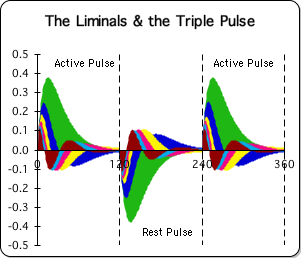
A Triple Active Pulse
Whoa! A Triple Active Pulse! This is the result when the Living Algorithm Program digests a data stream consisting of an uninterrupted series of 120 1s followed by an equivalent number of 2s and then 3s. What are the implications? Previously, it took a Rest Pulse of 0s to refresh the Active Pulse. Now a string of 2s generates another Active Pulse with no Rest Pulse in-between. Further, the following string of 3s generates yet another Active Pulse with no hint of the decelerating Rest Pulse. This Triple Active Pulse occurs without the need for a Rest Pulse. Doesn't this violate the tenets of the Triple Pulse? Is this some kind of perpetual motion machine? Don't we wish?
The Living Average steps up - generating unused data residue
A. Triple Active Pulse, Living Average & Data
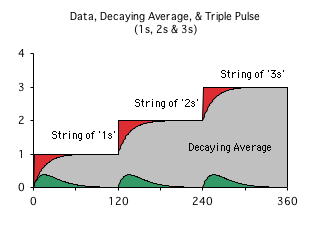
Let's look at another graph to see what is happening from another perspective.
The Living Algorithm digests the same data stream as before (a string of 1s, 2s, & 3s). However, this time the Living Average (grey) is highlighted in the foreground with the Data (red) in the background. Note that the red continues behind the grey. Notice that the Living Average makes rounded steps to move ever higher. Furthermore, each pulse of numbers has some data residue left over. The 3 red shapes reflect this surplus. This is quite different from the Living Average of the ideal Triple Pulse, shown below.
B. Living Average & Data from Triple Pulse Sequence
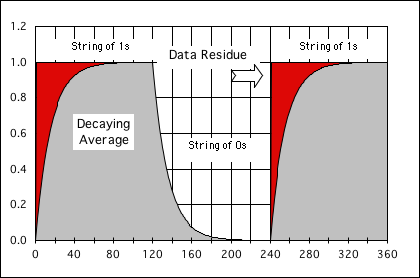
The most obvious difference between the two graphs is that Graph B rises and falls while Graph A steadily rises. In Graph B, the Living Average moves up with the string of 1s and down due to the introduction of a string of 0s. Conversely, in Graph A the curve rises in a step-like fashion due to the fact that the size of the number in each string increases.
Data Residue & Where it Goes: Active Pulses generate data residue, which drives the Rest Pulse
The second difference is more subtle. In Graph A, each pulse generates data residue (the red area), while in Graph B, the middle pulse does not generate any residue. Only Active Pulses generate data residue. Rest Pulses do not. In fact, the red data residue from the Active Pulse actually powers the following Rest Pulse. Without this residue, there is no Rest Pulse. In fact, as the data residue is used up, the Rest Pulse fades away. The final Active Pulse generates more data residue. This data residue fuels yet another Rest Pulse. The crucial point is simple. The Rest Pulse is required to drain off the excess data energy that is accumulated during the Active Pulse.
Living Algorithm Principle: The Complete Consumption of Info Energy
Why is there data residue? It is due to the way in which the Living Algorithm digests information. She takes raw data and spreads its info energy over time. With each repetition (iteration) of the Living Algorithm process, some, but not all, of the info energy is consumed. When the numbers in the data stream increase (3, 4, 5), excess info energy is stored. When the numbers in the data stream decrease (5, 4, 3), the excess info energy is utilized. The exchange of this stored and utilized ‘energy’ is due to a fundamental Living Algorithm principle. The entire amount of info energy that enters the Living Algorithm System must be utilized. This complete consumption of info energy is in direct contrast with the conservation of material energy. This feature also separates material from living systems. (This topic is discussed in more detail in our article on Info Energy.)
• Connecting Dots: Why is sleep more refreshing than a modality shift?
Let's take a stab at a question that emerges from this analysis. Why is sleep a necessity, if shifting modalities performs the same function – refreshing conscious attention?
The digestion of both food and data takes time. Accordingly, the Living Algorithm process doesn’t digest ‘non-zero’ data immediately, but instead leaves an undigested data residue as a byproduct. The data residue is the difference between the total data and the Living Average.
A. Triple Active Pulse
Living Average & Data

B. Triple Pulse
Living Average & Data

Let’s think of data residue as undigested information. Although shifting modalities refreshes attention, undigested information (data residue) continues to accumulate (the red area in Graph A). We absorb information continuously while we are awake. Sleep is an efficient and natural way to shut down the intake mechanism. When we are asleep, our subconscious has the opportunity to assimilate information – the data residue that has accumulated during the day. In this way, we zero out our system so that we can start the next day at maximum efficiency. As such, sleep, whether for hours at night or for minutes during the day, provides that opportunity. The unconscious state of sleep provides the extended time that is crucial for the digestion of information acquired during the conscious state of waking. Graph B exhibits this process. This analysis provides preliminary theoretical underpinning for our results.
• New Living Algorithm features required to understand Core Concept advantages
To understand this ubiquitous cultural phenomenon, it was necessary to explore other features of Living Algorithm’s digestive process. The Triple Pulse is just one of the Living Algorithm's myriad manifestations. To simulate the Core Concept Approach in a lecture or performance, she assumed the previously unseen persona of the Triple Active Pulse. To simulate the Continuous Approach in a lecture or performance, she digested a data stream that rose incrementally. The Living Algorithm’s digestive process is very flexible. This flexibility enables her to model life's innate nature as a biological information digester.
Preliminary results: Continuous Approach more effective than Core Concept
After the Living Algorithm went through her transformations, we examined the behavior of her individual components – the data stream derivatives. Upon first glance it seemed as if the Continuous Approach was going to win out as the more effective strategy. Studies have suggested that the Active Pulse/Directional (the green area) could be associated with consciousness. Consciousness in the Continuous Approach (the green area in Graph E) is steady and long, while consciousness in the Core Concept Approach (the green area in Graph F) occurs in pulses. What could be better for an hour-long lecture than a steady state of consciousness? Think again. Appearances are frequently deceiving.
E. Continuous Rise
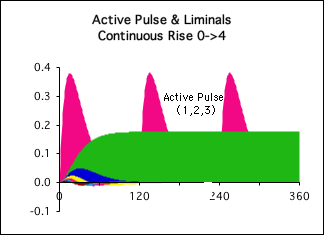
F. Core Concept
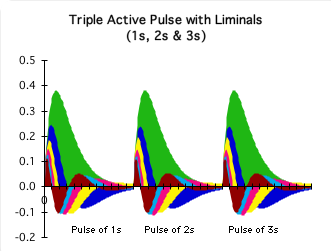
Studies have suggested that the Active Pulse/Directional (the green area) could be associated with consciousness, and that the Liminals (the multicolored swatches) could be associated with the subconscious digestion of information.
Core Concept's Liminals dwarf Continuous' Liminals
When we examined the behavior of the Liminals (the higher derivatives) our conclusions took an about-face. Prior studies have suggested that the Liminals could be associated with the subconscious digestion of information. The Liminals from the Core Concept Method (the multicolored areas in Graph F) were active and healthy, rising and falling regularly with each of the Three Active Pulses. Conversely, the Liminals from the Continuous Method (the multicolored areas in Graph E) were dwarfed in comparison. They never rose that high and disappeared before the end of the first pulse. We characterized this as the Lights On/Nobody Home Phenomenon.
Core Concept more inspired than Continuous Approach
Further, although the Active Pulse (consciousness) rose and fell during the Core Concept Approach, the peak was much higher than the sustained peak of the Continuous Approach. Experientially, the peak is associated with inspiration and insight. The implication is that the Core Concept Approach led to deeper insight and a greater ability to actually digest (learn, involve oneself with) the presented material.